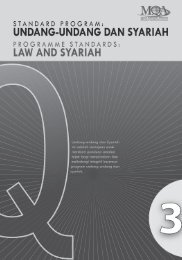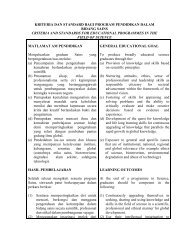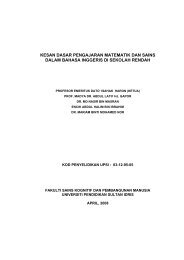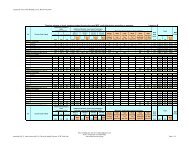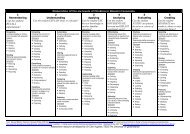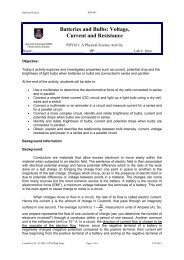OUTCOMES-BASED TEACHING AND LEARNING (OBTL) - DrJJ
OUTCOMES-BASED TEACHING AND LEARNING (OBTL) - DrJJ
OUTCOMES-BASED TEACHING AND LEARNING (OBTL) - DrJJ
Create successful ePaper yourself
Turn your PDF publications into a flip-book with our unique Google optimized e-Paper software.
6<br />
Twelve tips for good assessment practices:<br />
http://www.cshe.unimelb.edu.au/assessinglearning/07/index.html<br />
Good assessment practices by subject:<br />
http://www.cshe.unimelb.edu.au/assessinglearning/04/index.html<br />
Assessing group work:<br />
http://www.brookes.ac.uk/services/ocsd/firstwords/fw26.html<br />
http://www.cshe.unimelb.edu.au/assessinglearning/03/group.html<br />
Assessment ideas from HKUST:<br />
http://celt.ust.hk/ideas/afl/Mexam/index.html<br />
In many cases, the course ILOs are not of equal importance, some may be relatively more<br />
important than others. Care has to be taken that the weighting of the assessment task is<br />
appropriate in reflecting the relative importance of the ILOs. For instance, it is common in<br />
some universities to give the exam a weighting of 50%, every other task (“coursework”)<br />
50%, which almost inevitably means the lower level ILOs are over assessed at the expense of<br />
the higher level ones. The obvious answer is to change the weights between exam and other<br />
assessment tasks or to give more than one AT to the more important ILOs.<br />
Judging how well the assessment task has been performed - Marking versus Grading<br />
Probably most teachers “mark” students’ work: that is, using a quantitative scale, usually in<br />
percentages, to rate how well students are doing, or to award marks “bottom up” as the<br />
student makes correct points. The final grade is allocated according to the number of marks<br />
accumulated.<br />
<strong>OBTL</strong> fits most comfortably with grading, that is, allocating A, B, C etc. on the basis of the<br />
quality of students’ work, not on the number of marks accrued. Grading schemes that equate<br />
D with a “Marginal Pass” performance, C with “Average”, B with “Good” and A with<br />
“Excellent” are far too general. We need to generate grading criteria, or rubrics, to describe<br />
what an “Excellent” outcome may be for each task and for each ILO. These criteria are<br />
discussed in the following section.<br />
Developing Grading Criteria (Rubrics)<br />
The grading criteria, or rubrics, are the key to easy and successful grading. Such criteria need<br />
to suit the task presented. Generating them is a joint collegial responsibility so that all<br />
teachers in the department agree. The judgment is made according to the letter grade: if the<br />
performance barely makes the category it is a “minus”, if an excellent example of that grade<br />
of performance a “plus”. The numerical grade point can then be read from the grade point<br />
scale for the purpose of calculating final grades.<br />
Some URLs useful in designing grading criteria:




